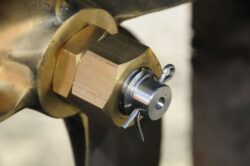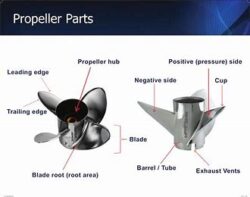Outboard engines rely on propellers to make the boat go. Improper props waste fuel, over rev the motor, and can damage it.
Most folks that buy new toys like boats, wheelers, RV’s, jet skis, and other motorized power craft routinely fail in one most important area, Maintenance. Tune ups, winterizing, routine fluid changes , and other routine checks are over looked.
Boat owners need to take a proper look at their propeller. This means removing the propeller for routine inspection. Examine the assembly for wear, add fresh grease to the shaft, and correctly torque the prop nut to the shaft.
Look for the torque values and recommendations from the dealer or manufacturer. Once you have the data, hand tighten the small jam nut to the hub. Use a standard wrench to comfortably tighten the assembly. Now add the full-sized nut and tighten independently. Prop nuts simply hold the prop on.
With the prop tilted out of the water, test the prop for play or wiggle. This should be minimal. This is a routine way to test the prop every trip.
The cup, rake, and pitch are all important to the prop adjustment. Cup affects fuel efficiency, ventilation, speed, and slip. Rake is the degree of slant that the blades have. Do your homework.
It is important to match the correct prop for your specific needs. A water ski boat needs a different prop than a fishing boat that trolls a lot. One of the most important things for a boater to know is the rev range of the engine. You can find it in the boat’s manual. You then need to use the tachometer to identify the correct information.
Having multiple props is not a bad idea. Having a spare makes a disaster solvable. During a trip, you may have different needs. Having a spare allows you to make a switch. Have the tools on board to do the job.
Changing props and routine inspection helps you to keep the boat tuned and efficient.
Montana Grant